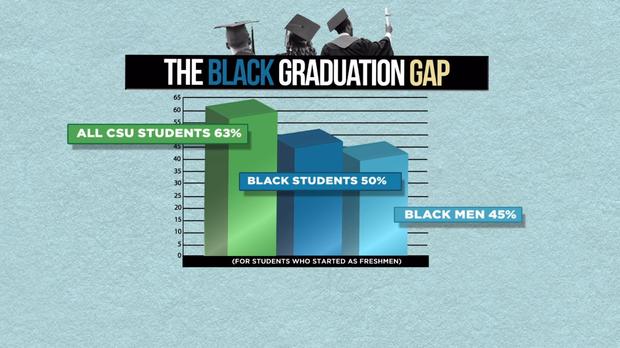"We don't want to hear uncomfortable data": Revealing the Black graduation gap at CSU schools
SACRAMENTO – As California State University students head back to school, data indicates that overall graduation rates are up. But stubborn racial inequities remain on CSU campuses.
In partnership with the non-profit newsroom CalMatters, CBS News is taking a closer look at the graduation equity gaps on Cal State campuses.
CSU has an ambitious 2025 goal of eliminating the graduation rate gap between so-called "underrepresented minorities" and other races.
The problem: the way CSU bundles so-called underrepresented minorities to track those achievement goals statistically ignores how the system is failing some Black students.
Students like Chris Carter.
"A lot of people would tell you to get to college, but the hardest part is staying in college," Carter said.
And Carter speaks from experience. The fifth-year senior started as a business major at Cal State Northridge but struggled as one of just a few Black students in his classes.
"And those two other Black men switched out of business," Carter said.
Eventually, so did Chris. Then one of those friends dropped out of school.
"I didn't feel like I had support from counselors or teachers," Carter said.
And he's not alone.
Across all 23 Cal State University campuses, 63 percent of students graduate in six years. That number drops to just 50 percent for Black students – and it's even lower for Black men, at 45 percent.
But you wouldn't know that by looking at CSU's student success dashboard, which lumps Native American, Black, and Latino students all together as so-called underrepresented minorities (or URM).
Latino students make up 90.80 percent of the group – statistically erasing Black (8.7 percent) and Native American (0.5 percent) students from the data.
If it sounds confusing, insiders tell us that's probably the point.
"My colleagues at the university would not want me to say this, but I will. Yeah, I think they are hiding it because they know that it's a problem," said Prof. Bob Rucker, retired journalism department chair at San Jose State.
"We don't want to hear uncomfortable data," added Prof. Kenneth Monteiro, former Dean of Human Relations at San Francisco State University, and former Dean of the first-in-the-nation College of Ethnic Studies at SFSU.
Both men say they've opposed the "Underrepresented Minority" metric for years because bundling the unrelated minority groups together hides how the system is failing certain groups.
"It's just methodologically, scientifically, wrong," Monteiro said.
"What's the point of being a bundler of people of color unless you're trying to say, 'We're doing something and that's enough,'" Rucker said.
For instance, in a report to lawmakers last year, the Cal State system highlighted how Chris Carter's school "saw the equity gap for underrepresented minority students' narrow" or improve by 4 percent.
Except, the report failed to mention, that the reason for the 4 percent decrease in the gap between so-called "underrepresented minority" students (URM) and "non-underrepresented minorities" (White, Asian and other groups) was the grad rate for the non-URM group actually got worse – dropping by 3 percent. The bundled underrepresented minority grad rate only improved by 1 percent.
They also didn't report that when you unbundle that data, the Black graduation rate actually got worse year over year and dropped 1 percent.
"If you're trying to impact the performance rates of Black students, you've got to look at Black students," Monteiro said.
While CSU's Public Equity Gap Dashboard compares bundled URM students to non-URM students, the unbundled raw data does exist.
But to identify the true graduation gap by race and ethnicity, our CalMatters reporting partner Mikhail Zinshteyn had to independently analyze CSU's raw data – downloading and combining multiple spreadsheets – then independently calculating the gap.
"It shouldn't be this hard," Monteiro said when we explained Zinshteyn's process. "But it is this hard because the institution reinforces omitting data that embarrasses it and rewards data that make it look good,"
CSU Trustee Julia Lopez cited Zinshteyn's data analysis at a recent CSU board meeting and asked what could be done in response.
"We may be making progress, but there (is) really [a] difference in groups," Lopez said.
CSU's Executive Vice Chancellor acknowledged the URM metric is flawed but stopped short of suggesting it be replaced with a tool that looks at individual and racial groups specifically.
"That's our sort of legacy metric, in fact, it's even in our Governor's compact, right? So we're being held to that progress," said Sylvia Alva, CSU's Executive Vice Chancellor.
That's right, California Gov. Gavin Newsom's administration is also using the questionable URM metric to judge CSU's progress toward closing equity gaps.
While the CSU says they also use other ethnicity metrics to work toward closing the equity gap, the bundled URM is the official measure of progress toward racial and ethnic equity goals. It's the public metric they're judged by.
Like many, Chris believes the way the system tracks equity by bundling unrelated minority groups together, hides how it is failing certain groups.
"Them trying to, you know, group us in. We're not going to get the resources that we need to graduate," Carter said. "Our struggles are not the same."
Notably, despite CSU's public equity goals and increased state funding, the graduation rate for Black students is 20 percentage points lower than for white, Asian, and other students (the non-URM group) – and has been for 15 years. While overall graduation rates have increased, the equity gap has not improved and is even slightly worse for Black students.
But you wouldn't know that by looking at the URM metric CSU publicly uses to track success.
"Should we be using a metric to track equity that clearly conceals how the system is failing certain students?" we asked Alva.
Though we never really got a straight answer from the CSU Executive Vice Chancellor.
"I'll be the first to acknowledge that that that is a very crude way of looking at these important, within group, their variabilities," Alva said.
She added that if it was up to her, she would change the metric but Alva didn't commit to a change, noting they've used the URM metric for years.
"I don't think it's wise for us to change the goalpost at this point," Alva said. "But we also can add and amplify what those goalposts are."
Alva stressed that CSU does internally analyze other equity data, and is aware of the equity disparities revealed by the CalMatters data analysis. However, they use the "crude" URM metric as the official accountability tool to track their progress.
Some previously high-ranking insiders, like Rucker and Monteiro, believe that's by design.
The Executive Vice Chancellor didn't directly respond when we asked about the assertions that the system tends to hide data that may be uncomfortable or embarrassing.
In response to the now public CalMatters data analysis, CSU made the raw dataset easier to find. "We have updated access to that dataset," Alva said.
Though, it still requires independent data analysis skills to identify the true equity gaps.
In contrast, San Diego State and San Jose State clearly and simply display their schools' un-bundled equity data so that viewers can easily spot differences between racial and ethnic groups.
Notably, San Diego State is an outlier in the CSU system and has nearly closed the Black graduation gap on its campus through robust resources and programs.
The programs that Chris Carter would like to see at all CSU schools.
At Northridge, Carter says it wasn't until he joined a Black fraternity that he finally felt he got the support he needed.
"You know, they were like, 'Hey, you know, if you need help with anything … even if I may not be your major, I can try to guide you and try to help you,'" Carter said.
While he wishes the CSU system would do more, Carter is doing his part to close the Black graduation gap.
"I'm gonna graduate. I'm gonna walk that stage and make my parents proud."
CalMatters Higher Education Reporter Mikhail Zinshteyn and CalMatters College Journalism Network fellow Michaella Huck contributed to this reporting.
This is the first in a series of stories examining graduation equity gaps in collaboration with CalMatters. Up next in our series, we take a closer look at the source of the problem and we examine campus success stories in an effort to identify possible solutions.
CalMatters will have more on the problem and possible solutions in a follow-up story next week.




